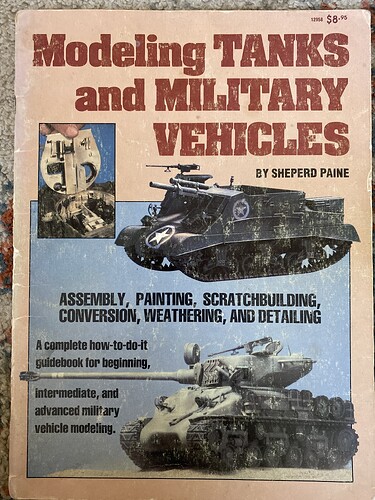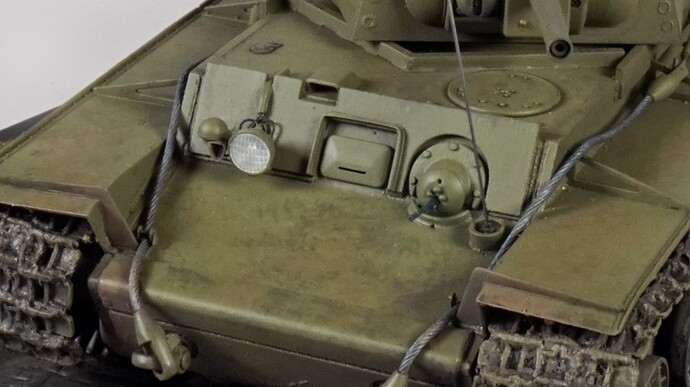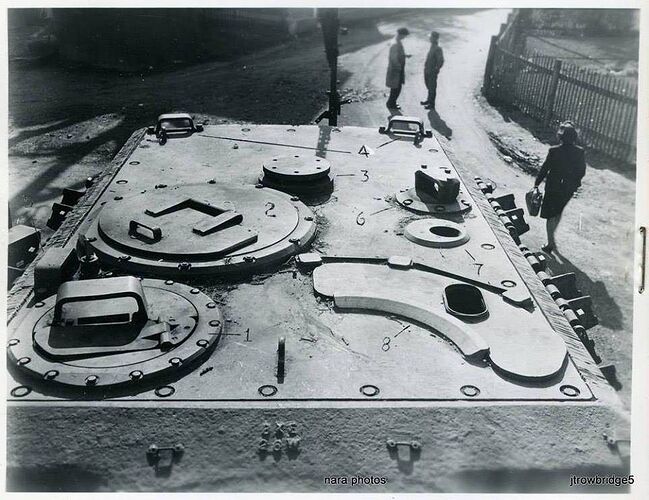Well, lets look at your process. Did you have to pry apart the hull to fix something obvious you forgot?
Did you use most of the parts in the kit?
How many glue fingerprints did you have to sand off?
Did you end up with any unfilled seams that you could slide your drivers license through?
Did you make it to the point paint is to be applied without dropping the whole mess in the garbage can?
So either you were not building an Alan kit or you are doing just fine.
Customization went too far when it effects the operation or accuracy of the firearm. It doesn’t matter if others laugh at your bedazzled weapon though.
Dear SSGT, thanks. I’ll check out those sources. I can say that my process on this build was roughly in the same order you specified. You’re definitely right on the over-capitalization of my arsenal. But, I’ll say this: I spent days and weeks cumulatively studying top notch modelers. More to ensure that whatever I was going to try, I studied it. And yes, along the way I either trashed some builds, or kept them for testing applications, or whatnot, then of course there’s VMS Clean Slate 3.0 if you totally screw the pooch on paint which I’ve done. So, on my way here, getting past one year now, I’ve had more mistakes than successes, but as of late they’re beginning to even out, if I’m trying to be objective. And it takes me a long time to do any build. Just building them is boring. I like to make scratch build parts. Anyway, my wife would tell you I’ve overspent on supplies, kits and she’s right. But boy it takes me forever to get one done. It’s a personality quirk of wanting to make it “right” or “real.” But I’ve got a shred of enough common sense to know now I’ve spent too much time on something which is not what others may see. I’m lucky enough to have an internationally renowned Polish modeler. He’s definitely counseling me along the lines you’ve laid out so I think people who know what they’re talking about have inculcated common sense into me. Thanks.
Dan
True.
If I am reading you correctly you are both overwhelmed by the availability and amount of weathering products and also somewhat new to the hobby. If that is the case it might be better for you if you focused on only one or two techniques/products at time. Work on achieving success and a comfort level on these before trying to master the next technique/product. Trying to do too many things at once usually results in mediocre results without gaining any proficiency in any area and generally results in increased frustration at the lack of progress.
To follow up on armorsmiths advice, consider picking up a copy of this
Very basic and clear finishing techniques developed far before any of the recent premade products and associated techniques. Develop a sound understanding of these prior to adding in some of the newer ones.
Wow - that book cover looks well-weathered! Did they dry-brush it? ![]()
Seriously, there’s a lot to be said for learning the Old-Skool ways before diving into all the modern products out there. Essentially there are washes, powders, and dry-brushing, with gloss and matte coats, and thinned oversprays. All that’s changed is the names on the packets! Get a few “old clunker” cheap models that can serve as test canvases as you try out new techniques, or practice existing ones to ensure you get the right result. After you finish using them to test “technique A”, hit 'em with a fresh coat of primer and do it again! I find it helps to pick junkers that are NOT you favourite subject, so you won’t be tempted to get attached to them…
To paraphrase what some have said: Weathering ends when the model looks right, not when you have used all the weathering products.
I don’t prime, I wash, rinse, and air dry after most assembly before painting. Most “primers” are just gray paint and do not provide any improvement in bonding later paint coats. They just add roughness and detail absorbing thickness. I find flaws with the first coat of the base color.
I don’t preshade, whatever that’s supposed to do.
I don’t chip. I will show wear either with pencils or a different shade of the color.
I don’t “filter”. I use glazes (tinted clear vehicle) applied with an airbrush.
I think people are suffering under an old Shep Paine instruction, something to the effect of “You should spend at least as much time painting and weathering a model as you did building it.” That may have been true when building a Monogram Weasel or Tamiya Panzer II took about four hours to finish, including the time for the glue to dry, but it’s not a requirement and works to your disadvantage with the more complex kits common today, especially if you take care to clean up the parts or do any sort of detailing.
It works OK for me.
As Crass said, “Reject the system that dictates the norms!”
KL
dear friend
i wanted to say, if i didn’t say it artfully enough before, i wholly agree. Jagdtigers were painfully aware of Allied air superiority so they frequently hid and shot from cover and concealment. Thus, i had this in mind when i began on my dark yellow version. There were reference images which showed the pure filth from combat and lack of opportunity to maintenance. so, i used my knowledge of their penchant to shoot from cover (backing into heavy forests, buildings etc. i’ll show my trash panda in a week or so but these images gave me inspiration
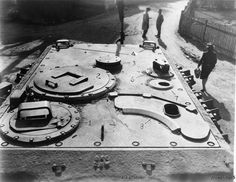
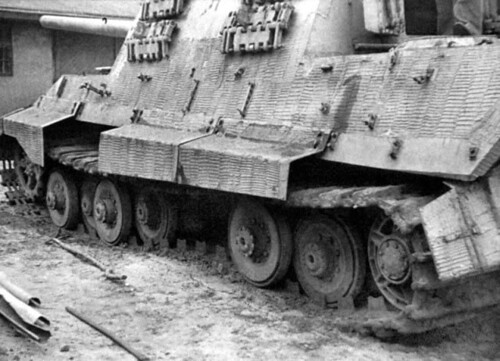
Thanks for your kind words earlier. That last photo reminded me of something I forgot. Side skirts. They are often lost and not readily replaced. The extra armor the provide is marginal and useful against a light AT weapon’s capacity to cause a mobility kill, but they are often more of a hassle than they’re worth because they limit access to the tracks for maintenance, or, worse, when you throw a track. Breaking off sections of side skirts is an easy way to show realistic combat abuse without making the tank look like a piece of scrap iron on a tank range.
It’s been well used over the years , got stuffed in many a school backpack and brought on scout camp outs a few times .
i agree Apache26. I always use PE skirts/fenders for more realistic and pliable work. Of course, there’s always the no fender models, esp for the Panzer heavies that i like
Dan
well top, i don’t think any of those situations applies to me. have i trashed kits? Yes, but for other reasons. My question was to pique the interest of experienced modelers to try to calculate a cohesive philosophy. i’m under one year at this hobby but i m ahead of the curve because i’m not afraid to try things or to take risks. They don’t always work but the process has enhanced my reservoir of patience and confidence. i wasn’t trying to be coy. i’m fascinated that experienced modelers such as yourself have some differing opinions. i certainly respect your opinion and i’m no duty expert. Semper Fi
Dan
thanks Armorsmith. i guess my purpose was to
get a panoply of views from.experienced modelers like you. I have an internationally renowned Polish modeler who is a mentor and friend… He’s been working with me and of course we don’t always agree on everything. But i appreciate your taking the time to help
Dan
Wow. Thanks Top. i must have swerved into your method. One thing is for sure, a man like you is a beacon of common sense and presence of mind and action. in all facets of life i’ll bet.
i planned this Henschel Dragon Jagdtiger build right down to the company markings via stencil and the 512th insignia. i even named it as many crews used to do. It’s a beat up dark yellow all beat up and all of the weathering and other choices were factored in ahead of time. Now that doesn’t mean that pro modelers will appreciate it but i think it’s pretty damn good for a relative newcomer with the proper gear and training and some good old Marine Corps ingenuity. Every choice has a reason. So, I think if i could go back and rewrite my post it would’ve sounded like “hey, what’s your weathering philosophy? That, instead of what i did say which was something like hey i have all this gear and i’m confused. That was stupid. but i take your point and methodology. Semper Fi
Dan
Thanks, I thought Jefferson or Madison was quoted on something along those lines. But I agree wholeheartedly
Dan
I like the Horse Sense of your response. While I can’t say I do everything you do, or don’t do things you don’t do, I see your point, viz, don’t just throw everything at a build for the sake of it. I think TopSmith mentioned to me one should have an idea of what the build should be before it’s built, absent mid-build inspiration, and work toward that end. I happen to espouse that thinking. Most AFV’s that survive more than a couple of months are going to be beat to s**t. As in my current build, the Dragon 1/35 Henschel Jagdtiger, they typically shot from cover and concealment which meant they’d back into a forest or a building if it wasn’t too tall and shoot from there due to Allied air superiority. Many were knocked out by RAF Typhoons or P-47’s. I had some fun and used my artistic license to create an anonymous build , but with proper markings right down to the company and battalion to which it was assigned. I used metal stencils for those. Two kill rings on the barrel and some mild battle damage. Mostly wear and tear. Some of the JT’s I’ve seen in Culver and Devey’s book were a complete mess. Thanks Kurt
Hi Top. You mentioned in your last whether I’ve ever had to pry apart a hull. Answer: no. Why? I still haven’t done it, although I could’ve. It’ll be the last thing I do. If I need to fill any seams I’ll handle it then. I’ve got a lot of hardware up in the upper hull/casemate esp from those doohickey tie downs I scratch built. If one popped loose before I was done I could easily fix it. I’m also very distrustful of plastic cements. They don’t always work, especially on kit periscopes or CA glue with resin ones. Maybe I’m over-cautious, but I’ll deal with mating the hulls last. I haven’t noticed anything that would make me think they wouldn’t fit. I’ve dry fit them numerous times as I’ve been going along. Thanks
Dan
This is an outstanding statement. As long as this is the basis of your weathering philosophy, you’re good to go.
thx for the tip. I ran out and got most of the big hardcovers on heavy Panzers. but those are just references. a book on weathering is always a good idea.
